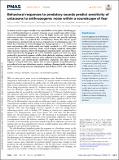Files in this item
Behavioral responses to predatory sounds predict sensitivity of cetaceans to anthropogenic noise within a soundscape of fear
Item metadata
| dc.contributor.author | Miller, Patrick J. O. | |
| dc.contributor.author | Isojunno, Saana | |
| dc.contributor.author | Siegal, Eilidh | |
| dc.contributor.author | Lam, Frans-Peter A. | |
| dc.contributor.author | Kvadsheim, Petter H. | |
| dc.contributor.author | Curé, Charlotte | |
| dc.date.accessioned | 2022-03-24T09:41:15Z | |
| dc.date.available | 2022-03-24T09:41:15Z | |
| dc.date.issued | 2022-03-29 | |
| dc.identifier | 278389536 | |
| dc.identifier | 68272bfa-54dd-425a-b018-e24f25568bb5 | |
| dc.identifier | 85126886598 | |
| dc.identifier | 000780672800017 | |
| dc.identifier.citation | Miller , P J O , Isojunno , S , Siegal , E , Lam , F-P A , Kvadsheim , P H & Curé , C 2022 , ' Behavioral responses to predatory sounds predict sensitivity of cetaceans to anthropogenic noise within a soundscape of fear ' , Proceedings of the National Academy of Sciences of the United States of America , vol. 119 , no. 13 , e2114932119 . https://doi.org/10.1073/pnas.2114932119 | en |
| dc.identifier.issn | 0027-8424 | |
| dc.identifier.other | Bibtex: doi:10.1073/pnas.2114932119 | |
| dc.identifier.other | ORCID: /0000-0002-2212-2135/work/110423120 | |
| dc.identifier.other | ORCID: /0000-0002-7833-302X/work/110423316 | |
| dc.identifier.uri | https://hdl.handle.net/10023/25086 | |
| dc.description | Funding was provided by the US Navy Living Marine Resources and Office of Naval Research programs, Netherlands Ministry of Defence, Norwegian Ministry of Defence, UK Defence Science and Technology Laboratory, and DGA French Ministry of Defence. | en |
| dc.description.abstract | Acoustic signals travel efficiently in the marine environment, allowing soniferous predators and prey to eavesdrop on each other. Our results with four cetacean species indicate that they use acoustic information to assess predation risk and have evolved mechanisms to reduce predation risk by ceasing foraging. Species that more readily gave up foraging in response to predatory sounds of killer whales also decreased foraging more during 1- to 4-kHz sonar exposures, indicating that species exhibiting costly antipredator responses also have stronger behavioral reactions to anthropogenic noise. This advance in our understanding of the drivers of disturbance helps us to predict what species and habitats are likely to be most severely impacted by underwater noise pollution in oceans undergoing increasing anthropogenic activities. As human activities impact virtually every animal habitat on the planet, identifying species at-risk from disturbance is a priority. Cetaceans are an example taxon where responsiveness to anthropogenic noise can be severe but highly species and context specific, with source–receiver characteristics such as hearing sensitivity only partially explaining this variability. Here, we predicted that ecoevolutionary factors that increase species responsiveness to predation risk also increase responsiveness to anthropogenic noise. We found that reductions in intense-foraging time during exposure to 1- to 4-kHz naval sonar and predatory killer whale sounds were highly correlated (r = 0.92) across four cetacean species. Northern bottlenose whales ceased foraging completely during killer whale and sonar exposures, followed by humpback, long-finned pilot, and sperm whales, which reduced intense foraging by 48 to 97level responses to killer whale playbacks, implying a similar level of perceived risk. The correlation cannot be solely explained by hearing sensitivity, indicating that species- and context-specific antipredator adaptations also shape cetacean responses to human-made noise. Species that are more responsive to predator presence are predicted to be more disturbance sensitive, implying a looming double whammy for Arctic cetaceans facing increased anthropogenic and predator activity with reduced ice cover. | |
| dc.format.extent | 8 | |
| dc.format.extent | 1529789 | |
| dc.language.iso | eng | |
| dc.relation.ispartof | Proceedings of the National Academy of Sciences of the United States of America | en |
| dc.subject | Evolution | en |
| dc.subject | Cetacea | en |
| dc.subject | Disturbance | en |
| dc.subject | Naval sonar | en |
| dc.subject | Risk-disturbance hypothesis | en |
| dc.subject | QH301 Biology | en |
| dc.subject | DAS | en |
| dc.subject | SDG 14 - Life Below Water | en |
| dc.subject | MCC | en |
| dc.subject.lcc | QH301 | en |
| dc.title | Behavioral responses to predatory sounds predict sensitivity of cetaceans to anthropogenic noise within a soundscape of fear | en |
| dc.type | Journal article | en |
| dc.contributor.institution | University of St Andrews. Sea Mammal Research Unit | en |
| dc.contributor.institution | University of St Andrews. Marine Alliance for Science & Technology Scotland | en |
| dc.contributor.institution | University of St Andrews. Scottish Oceans Institute | en |
| dc.contributor.institution | University of St Andrews. Institute of Behavioural and Neural Sciences | en |
| dc.contributor.institution | University of St Andrews. Centre for Social Learning & Cognitive Evolution | en |
| dc.contributor.institution | University of St Andrews. School of Biology | en |
| dc.contributor.institution | University of St Andrews. Bioacoustics group | en |
| dc.contributor.institution | University of St Andrews. School of Mathematics and Statistics | en |
| dc.contributor.institution | University of St Andrews. Centre for Research into Ecological & Environmental Modelling | en |
| dc.identifier.doi | https://doi.org/10.1073/pnas.2114932119 | |
| dc.description.status | Peer reviewed | en |
This item appears in the following Collection(s)
Items in the St Andrews Research Repository are protected by copyright, with all rights reserved, unless otherwise indicated.

